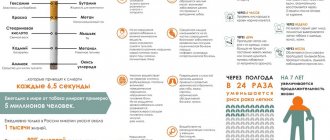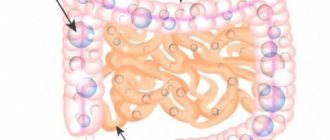Diseases of the heart and blood vessels.
According to statistics, about a third of all cases of cardiovascular disease in people under 65 years of age are associated with smoking. Tobacco use damages the heart muscle and blood vessels and increases the risk of developing the following common and often fatal diseases:
Stroke. For smokers under 65 years of age, the risk of stroke is three times higher than for non-smokers of the same age.
Peripheral vascular diseases. This is a narrowing of the arteries of the lower extremities, which can lead to their blockage and disruption of blood supply to the tissues of the legs. Sometimes peripheral vascular disease can cause amputation. Smoking is the main risk factor for these diseases. In addition, it is smokers who are characterized by the so-called intermittent claudication - a symptom complex that represents periodic pain caused by impaired blood supply to the lower extremities.
An abdominal aortic aneurysm is a rupture of the largest artery leading from the heart. Often leads to sudden death, and tobacco use is a major risk factor for this condition.
When combined with birth control pills, smoking increases the risk of heart attack and stroke in women. This risk increases sharply with age and women over 35 are especially at risk.
Tobacco smoke is absolutely recognized as carcinogenic to humans. It is a mixture of thousands of compounds, many of which contribute to cancer. And this entire “cocktail” enters the smoker’s unprotected lungs, with saliva into the stomach, and, having been absorbed through the walls of the lung and stomach, into the blood, then it is excreted in the urine, acting on the mucous membrane. 1. Cancer of the lungs, trachea and bronchi (90%). Women who smoke are 12 times more likely to die from lung cancer and men who smoke are 22 times more likely to die from lung cancer than non-smokers. 2. Cancer of the larynx (84%). 3. Cancer of the oral cavity, including lips and tongue (92%). 4. Esophageal cancer (78%). 5. Pancreatic cancer (29%). 6. Bladder cancer (47%). 7. Kidney cancer (48%). Smoking during pregnancy has a direct effect on fetal growth. Children of smoking women weigh on average 200 g less than non-smoking women. It is known that because of cigarettes, a mutation occurs, and children are born into the world with such defects as heart defects, strabismus, inguinal hernia, cleft palate, cleft lip, and mental development abnormalities. The smoker greedily inhales the fragrant smoke, without, of course, thinking about what each such puff causes in the body. The mouth and nasopharynx are the first to come into contact with tobacco smoke. Passing through a layer of tobacco filling, the smoke from smoldering tobacco, although it has time to cool, but not enough to equal the temperature of the oral cavity. Usually the temperature of tobacco smoke is 55-60 degrees Celsius. The temperature of the air entering the mouth is 40 degrees lower than the temperature of the smoke. Such significant temperature changes affect the condition of tooth enamel. Over time, microscopic cracks appear on it - entry gates for microorganisms. As a result, smokers' teeth begin to decay earlier. Tobacco tar is deposited on their surface, the teeth turn yellow, and the oral cavity begins to emit a specific odor. The temperature of the smoke affects the mucous membranes of the mouth and nasopharynx. The capillaries expand, the mucous membrane (cheeks, palate, gums) becomes inflamed. The heat of tobacco smoke and the chemicals contained in it (ammonia, acids, etc.) irritate the salivary glands, causing increased salivation. Toxic substances in smoke (aniline, hydrogen sulfide, etc.), passing into saliva, act on the gastric mucosa. Loss of appetite, pain in the stomach, constipation alternates with diarrhea. The result is chronic gastritis and, finally, ulcers of the stomach and duodenum. Tobacco smoke has an irritating effect on the mucous membrane of the pharynx. Smoking is especially harmful during illness, which often leads to a sharp deterioration of the condition. By the way, the most significant risk factors for atherosclerosis include: physical inactivity (sedentary lifestyle); smoking tobacco; excess body weight. Prevention and treatment of bronchial asthma is not complete without a smoking ban. One of the causes of bronchitis, along with a viral or bacterial infection (influenza, measles, whooping cough, etc.), exposure to toxic substances (some chemical warfare agents, a number of industrial poisons, irritating dust), is smoking. During treatment and prevention, a smoking ban is imposed. In case of hypertension, in treatment and prevention, a ban on smoking and alcoholic beverages is mandatory. Smoking has a general weakening effect on the body and contributes to the development of a variety of diseases.
Stop smoking!
Respiratory diseases.
First of all, tobacco smoke enters the respiratory organs and affects them. Tars and other toxic substances contained in tobacco combustion products lead to chronic diseases of the respiratory tract.
Chronic obstructive pulmonary disease - damage to the alveoli and small bronchi. This disease is extremely rare in non-smokers, it is very severe and, most importantly, irreversible. So far, medicine can only slow down its development.
Chronical bronchitis. Its main symptoms are a regular cough and increased sputum production. Occurs in approximately half of heavy smokers.
Decreased lung function. A person who smokes cannot breathe as deeply and efficiently as a non-smoker, which means that their body receives much less oxygen.
Signs of a “smoker's face”
An experienced heavy smoker can be recognized by sight, since it is on the face that all the consequences of an addiction appear most clearly. The term “smoker's face” was coined more than 30 years ago by the famous English doctor Douglas Model. He was able to scientifically prove that nicotine negatively affects the condition of blood vessels. Under the influence of toxins, the vascular wall contracts, especially the blood vessels in the facial area.
Carbon monoxide produced in the body as a result of smoking a cigarette displaces the oxygen needed to maintain normal skin condition. Its structure and color change due to insufficient supply of nutrients.
Clear signs of nicotine addiction appear more and more clearly on the face:
- A clearly defined nasolabial fold, deep facial wrinkles extending from the corners of the mouth.
- A clearly defined network of wrinkles located near the eyes (“crow’s feet”).
- Unhealthy skin color - from pale gray to bluish-red (due to malnutrition).
- Sharply defined contour of the cheekbones.
- Pronounced bags, circles under the eyes - they can be purple, blue, reddish, light brown.
Taken together, all these signs indicate adherence to a bad habit, and it is sometimes very difficult to get rid of them, even after quitting smoking.
Deterioration of reproductive function.
Smoking reduces the chances of conceiving and at the same time increases the risk of ectopic pregnancy and miscarriage.
Tobacco use increases the frequency of painful menstruation and menstrual irregularities. Statistics show that menopause occurs earlier in women who smoke.
In addition, smoking during pregnancy disrupts the normal intrauterine development of the fetus. This leads to the baby being born prematurely, with low weight and other complications. Nicotine can also trigger premature labor and increase the risk of bleeding during labor. Researchers have linked tobacco use during pregnancy to the subsequent development of obesity in the unborn child.
Men who smoke have an increased risk of developing erectile dysfunction, that is, decreased potency. In addition, heavy smokers often experience a decrease in the volume of sperm produced, the number of sperm in the ejaculate, and a deterioration in the overall quality of sperm, which negatively affects a man’s reproductive potential.
Why does the skin suffer?
Many factors have a negative impact on the skin, including direct exposure to sunlight, sudden weight gain or loss, working outside, and poor environment. But none of them can compare in terms of the negative impact of smoking. Cigarettes cause much more harm; nicotine triggers the aging process of the skin, causing age-related changes to appear on it. And some of them cannot be corrected, despite cosmetic procedures.
When nicotine enters a smoker’s body, it contributes to the development of a deficiency of oxygen and other nutritional components. As a result, the skin becomes pale and dry - regardless of the age of the person suffering from the addiction. Over time, the skin loses more and more elasticity, the complexion appears uneven, and pigmentation appears.
The chemicals in tobacco smoke destroy collagen fibers that provide skin elasticity. A smoker can be recognized by loose skin with wrinkles that do not correspond to his true age. Such problems affect not only cigarette lovers themselves, but also people who are forced to constantly inhale smoke - the so-called “passive” smokers.
Each cigarette smoked increases the damage done to the skin, which manifests itself in the following effects:
- The appearance of nasolabial folds is the area of the face that suffers most from the effects of nicotine. When tightening, certain muscles are activated, resulting in the appearance of facial wrinkles. This process is aggravated due to the loss of skin elasticity.
- Loss of elasticity - smoker's skin becomes more flabby. Moreover, the skin on the entire surface of the body suffers, but most severely on the face and hands. Women prone to this addiction often have sagging breasts.
- Increased pigmentation – age spots usually appear as a result of age-related changes or as a result of prolonged exposure to direct sunlight. But in heavy smokers, such processes are always much more pronounced.
- Alopecia – hair loss is caused by a deficiency of microelements necessary for hair health, which develops due to smoking. Nicotine negatively affects the condition of hair follicles, hair gradually becomes depleted and actively falls out.
- Skin diseases - smokers more often develop inflammatory lesions; the face, scalp, and hands are most susceptible to dermatological diseases.
Decreased immune system functions.
Smokers are more susceptible to bacterial and viral infections. Most often, those that affect the respiratory system, ranging from the common cold and flu, ending with Legionnaires' disease (a severe infectious disease with a high mortality rate that affects the lungs, central nervous system, and digestive organs) and tuberculosis. In addition, tobacco use increases the risk of contracting certain sexually transmitted diseases, such as the human papillomavirus.
Smoking increases the risk of developing autoimmune diseases, including rheumatoid arthritis, systemic lupus erythematosus and multiple sclerosis.
Is smokeless tobacco use dangerous?
The safety of snuff and chewing tobacco is a dangerous misconception. The chemical composition of these products is similar to smoking types of tobacco products, and therefore causes the same devastating harm to the body. About 70 substances included in smoking tobacco products are carcinogenic. There are 28 such toxic substances in smokeless tobacco products.
Quitting smoking significantly reduces the risk of developing the diseases listed above, and in the case of some diseases - for example, stroke - it can be brought to the level of a person who has never smoked.
Smoking and using tobacco products in other ways is accompanied by a serious blow to the entire body. A smoker spends exorbitant amounts of money to harm himself. You can refuse this - and within a couple of weeks you will begin to feel better, because lung function will improve, combustion products will disappear from the blood, and shortness of breath will disappear.
It is never too late to start treatment for nicotine addiction. You can take the first step by scheduling a consultation with a specialist at our clinic.
Neurological disorders.
Smoking causes an increased risk of developing Alzheimer's disease and dementia (acquired dementia associated with cerebrovascular accident).
Statistics show that hearing loss, loss of smell and sleep disturbances are often associated with tobacco use.
- "21st Century Could See a Billion Tobacco Victims" (PDF). Tobacco News Flash (Tobacco-Free Missouri Coalition) 3 (12): 1. 2007. Retrieved 2012-05-06. https://ws.missouristate.edu/breatheeasymo/upload/Newsletters/Newsletter62.pdf
- "Lung Cancer and Smoking" (PDF). Fact Sheet. www.LegacyForHealth.org. 2010-11-23. Retrieved 2012-05-06.
- According to the US National Institute on Drug Abuse. https://www.drugabuse.gov/publications/research-reports/tobacco/what-are-medical-consequences-tobacco-use/.
- Joyce JW (May 1990). "Buerger's disease (thromboangiitis obliterans)". Rheumatic Diseases Clinics of North America 16(2):463–70.
- Lederle FA, Larson JC, Margolis KL, Allison MA, Freiberg MS, Cochrane BB, Graettinger WF, Curb JD (2008). "Abdominal aortic aneurysm events in the women's health initiative: cohort study." BMJ 337:a1724.
- Devereux G (May 2006). ABC of chronic obstructive pulmonary disease. Definition, epidemiology, and risk factors". BMJ 332(7550):1142–1144.
- Ward C, Lewis S, Coleman T (2007). "Prevalence of maternal smoking and environmental tobacco smoke exposure during pregnancy and impact on birth weight: retrospective study using Millennium Cohort." BMC Public Health 7: 81.
- Peate I (2005). "The effects of smoking on the reproductive health of men." British Journal of Nursing 14 (7): 362–366.
- Johnson GK, Slach NA (Apr 2001). "Impact of tobacco use on periodontal status." Journal of Dental Education 65(4): 313–21.
- Jha P, Jacob B, Gajalakshmi V, Gupta PC, Dhingra N, Kumar R, Sinha DN, Dikshit RP, Parida DK, Kamadod R, Boreham J, Peto R (Mar 2008). "A nationally representative case-control study of smoking and death in India." The New England Journal of Medicine 358(11): 1137–1147.
- Almeida OP, Hulse GK, Lawrence D, Flicker L (Jan 2002). "Smoking as a risk factor for Alzheimer's disease: contrasting evidence from a systematic review of case-control and cohort studies." Addiction 97(1):15–28.
Skin care rules
To restore the skin, both single procedures and complex measures are prescribed, involving a combination of several techniques. Which of them are suitable for a particular person depends on many factors, including the severity of negative changes in the skin. And if it is enough for one to undergo a course of injection procedures (for example, mesotherapy), then another will need longer treatment using phonophoresis, laser therapy, ultrasound peeling, etc.
Skin care should also be individual and consist of several stages:
- Using foam or cosmetic milk to thoroughly cleanse the surface of the face.
- Increasing skin tone with lotion or tonic.
- Deep cleansing of the skin, for which special gommages and scrubs are used. You can also use an enzyme peel to remove any old cells. This will prepare the skin for the deepest penetration of beneficial substances contained in nourishing creams.
- Gently massage the skin using creams and oils - they are selected taking into account the specifics of the skin.
- Applying nourishing creams to the skin of the face, which at the same time have a moisturizing effect.
- From time to time it is necessary to make masks using products that promote a deeper supply of nutrients.
- The use of products that restore the protective properties of the skin.
It is important to choose the right products so that skin restoration occurs in two directions. The first is a rapid improvement in the appearance of the skin through the use of active ingredients. They not only cleanse, nourish and moisturize the skin, but also protect it from harmful factors, including tobacco smoke. The second direction is therapeutic, it consists of a deeper effect on the epidermis. As a result of exposure to special components, the natural skin restoration mechanism is launched.
What allows you to achieve a complex effect:
- The skin's own immunity is restored.
- The regenerative abilities of skin cells improve.
- The process of synthesis of your own collagen, elastin, and glycosaminoglycans is normalized.
- The cells that make up the basal epidermal layer begin to actively divide, stabilizing the process of skin renewal.
- Antioxidants entering the skin stimulate the elimination of toxins and free radicals formed as a result of smoking.
In some cases, it is impossible to do without hardware techniques that effectively complement and enhance the effect of care procedures. As a result, the penetration of beneficial components from cosmetic products into the skin improves. For this purpose, specialists prescribe photo- and phonophoresis, oxymesotherapy, ionogalvanotherapy, and microcurrent therapy. Vascular defects on the face can be corrected using laser coagulation, photo- or electrotherapy.
Sign up for the procedure right now







